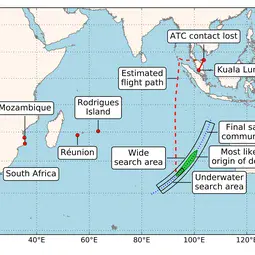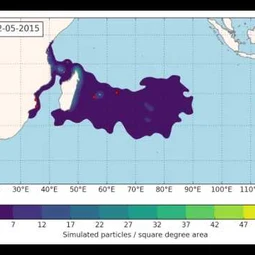New study reveals where MH370 debris more likely to be found
A team of researchers in Italy has used the location of confirmed debris from MH370 to determine where the airliner might have crashed, and where further debris could be found. The study is published today (27 July) in Natural Hazards and Earth System Sciences, an open access journal of the European Geosciences Union (EGU).
“Our result is the first to calculate the movement of the debris that best agrees with all five of the currently confirmed discoveries. This should make it the most accurate prediction,” says Eric Jansen, a researcher at the Euro-Mediterranean Center on Climate Change in Italy and lead-author of the study.
In March 2014, Malaysia Airlines Flight MH370 vanished with 239 passengers and crew on board. Extensive search efforts in the southern Indian Ocean, where the aircraft is thought to have crashed, have yet to locate the main wreckage, though debris have washed up on the African east coast and Indian-ocean islands.
The northern half of the area where authorities are currently searching for the plane, off the coast of Australia, overlaps with the area the new simulation indicates as the most likely origin of the debris found so far. “However, our simulation shows that the debris could also have originated up to around 500 km further to the north,” says Jansen. “If nothing is found in the current search area, it may be worth extending the search in this direction.”
To find out how MH370 debris drifted since the crash, the researchers ran a computer model that used oceanographic data from the EU Copernicus Marine Environment Monitoring Service, including data of global surface currents and winds over the past two years. To improve their simulation, they used the locations of the five confirmed debris found to date: two in Mozambique and one each in Réunion, South Africa and Rodrigues Island (Mauritius).
They started their computer simulation by placing a large number of virtual particles in the ocean, and then examined where they would go based on the ocean currents and winds after the crash. Since the exact crash location and how much of an effect wind has on the debris are unknown, researchers simulate different scenarios. From this, they could construct a so-called superensemble: a combination of simulations that best describes the debris found so far.
“Imagine that you want to know what the weather is going to be tomorrow, but you have several websites that give contradictory information. Which one do you trust? You check what weather they predicted for today and you put more faith in the websites that were correct and less in those that were wrong,” Jansen explains. “This is more or less what we do for MH370: we perform many simulations that are all plausible given the information that we know about the flight. When we combine the results of all these simulations, we give more importance to those that predicted the debris that was found correctly.”
“If new debris is discovered, we can update the result in a matter of minutes,” says Jansen. In the first stage of the simulation, the computer model calculates the various ways in which debris could have drifted, which takes some time on their supercomputer. But the locations of the discovered debris are only used in the final stage, when combining the possible drift paths to find the most likely ones. Once the first stage of the computer model is run, it is quick and easy to incorporate new debris data.
The results indicate that the most probable locations to discover additional washed up debris are Tanzania and Mozambique, as well as the islands of Madagascar, Réunion, Mauritius and the Comoros. The main wreckage is likely to be in the wide search area between 28°S and 35°S (see Figure 1). This overlaps with the current underwater search area between 32°S and 35°S, but indicates the airliner could also be further north than where authorities are currently searching.
“The disappearance of flight MH370 is probably one of the most bizarre events in modern history. It is important to understand what happened, not only for all the people directly involved, but also for the safety of aviation in general. We hope that we can contribute to this, even if our study is just a small piece of a very complicated puzzle.”
###
Please mention the name of the publication (Natural Hazards and Earth System Sciences) if reporting on this story and, if reporting online, include a link to the paper (http://www.nat-hazards-earth-syst-sci.net/16/1623/2016/) or to the journal website (http://www.natural-hazards-and-earth-system-sciences.net).
More information
This research is presented in the paper ‘Drift simulation of MH370 debris using superensemble techniques’ to appear in the EGU open access journal Natural Hazards and Earth System Sciences on 27 July 2016.
The scientific article is available online, free of charge, from the publication date onwards, at http://www.nat-hazards-earth-syst-sci.net/16/1623/2016/. A pre-print version of the final paper is available for download below.
Citation: Jansen, E., Coppini G., and Pinardi, N.: Drift simulation of MH370 debris using superensemble techniques, Nat. Hazards Earth Syst. Sci., 16, 1623–1628, doi:10.5194/nhess-16-1623-2016, 2016.
The team is composed of Eric Jansen (Euro-Mediterranean Center on Climate Change [CMCC], Lecce, Italy), Giovanni Coppini (CMCC) and Nadia Pinardi (Department of Physics and Astronomy, Alma Mater Studiorum University of Bologna, Italy and CMCC).
The European Geosciences Union (EGU) is Europe’s premier geosciences union, dedicated to the pursuit of excellence in the Earth, planetary, and space sciences for the benefit of humanity, worldwide. It is a non-profit interdisciplinary learned association of scientists founded in 2002. The EGU has a current portfolio of 17 diverse scientific journals, which use an innovative open access format, and organises a number of topical meetings, and education and outreach activities. Its annual General Assembly is the largest and most prominent European geosciences event, attracting over 11,000 scientists from all over the world. The meeting’s sessions cover a wide range of topics, including volcanology, planetary exploration, the Earth’s internal structure and atmosphere, climate, energy, and resources. The EGU 2017 General Assembly is taking place in Vienna, Austria, from 23 to 28 April 2017. For information about meeting and press registration, please check http://media.egu.eu closer to the time of the conference, or follow the EGU on Twitter and Facebook.
If you wish to receive our press releases via email, please use the Press Release Subscription Form at http://www.egu.eu/news/subscribe/. Subscribed journalists and other members of the media receive EGU press releases under embargo (if applicable) in advance of public dissemination.
Natural Hazards and Earth System Sciences (NHESS) is an interdisciplinary and international journal dedicated to the public discussion and open-access publication of high-quality studies and original research on natural hazards and their consequences. Embracing a holistic Earth system science approach, NHESS serves a wide and diverse community of research scientists, practitioners, and decision makers concerned with detection of natural hazards, monitoring and modelling, vulnerability and risk assessment, and the design and implementation of mitigation and adaptation strategies, including economical, societal, and educational aspects.
Contact
Eric Jansen
Researcher at the Euro-Mediterranean Center on Climate Change (CMCC)
Lecce, Italy
Phone +39 0832-671042
Email eric.jansen@cmcc.it
Bárbara Ferreira
EGU Media and Communications Manager
Munich, Germany
Phone +49-89-2180-6703
Email media@egu.eu
X @EuroGeosciences
Mauro Buonocore
Communication & Media Office, CMCC
Phone +39 0832 671060
Email mauro.buonocore@cmcc.it
Links
- Scientific paper (link active after embargo lifts)
- Journal – Natural Hazards and Earth System Sciences
- Read this press release in simplified language, aimed at 7–13 year olds, on our Planet Press site



